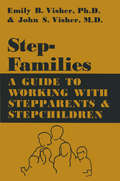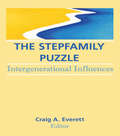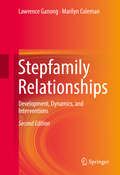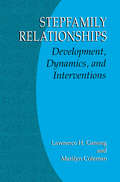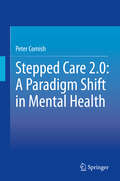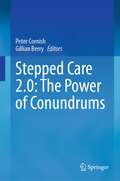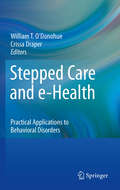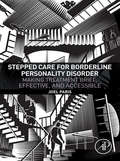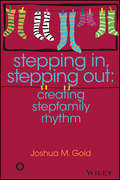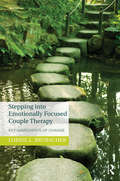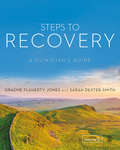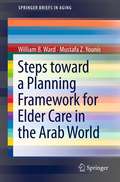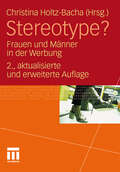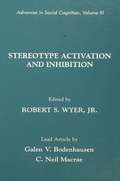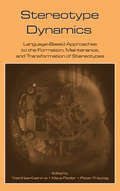- Table View
- List View
Stepfamilies: A Guide To Working With Stepparents And Stepchildren
by Emily B. VisherStudies the differences between stepfamilies and nuclear families, and the adjustments and stresses families face as a result of remarriage. Demonstrates numerous therapeutic models with techniques which may be used in individual or group therapy Special attention given to the problems of children in stepfamilies.
Stepfamilies: A Guide To Working With Stepparents And Stepchildren
by Emily B. VisherStudies the differences between stepfamilies and nuclear families, and the adjustments and stresses families face as a result of remarriage. Demonstrates numerous therapeutic models with techniques which may be used in individual or group therapy Special attention given to the problems of children in stepfamilies.
The Stepfamily Puzzle: Intergenerational Influences
by Craig EverettDo stepfamilies experience greater levels of stressors than first families? Do they also experience more negative manifestations of stress? Find the latest research on these questions and more in this groundbreaking exploration of the complex factors and dynamics that make up stepfamilies. The Stepfamily Puzzle fills a gap in research that has not kept pace with the rapid growth of interest in this subject. It sets some of the pieces of the stepfamily puzzle into an intergenerational framework that includes the roles of grandparents, parent-child interactions, the struggles to define boundaries and achieve marital intimacy, and the underlying effects of financial support on stepfamily well-being. The Stepfamily Puzzle compares the effects of stress in stepfamilies and conditions in other families and reveals that the differences between the two types of families may not be as dramatic as long assumed. It also examines in-depth the emotional and financial stressors that impact stepfamilies and how this stress is exhibited in family relationships. Other groundbreaking research presented in this book includes: the closeness of relationships between children and grandparents in stepfamilies as compared to children and grandparents in first families effects of ongoing attachment to the former spouse on post-divorce relationships stepsibling subsystems a comparison of self-esteem and behavior problems of stepchildren and children in other family structures social support received by children in stepmother, stepfather, and intact families quality of stepfather-adolescent relationships effect of child support on stepfamily satisfactionTherapists, attorneys, and those interested in the numerous therapeutic and psychoeducational programs, self-help groups, and trade literature available on stepfamily relationships will find The Stepfamily Puzzle a valuable introduction to current research in this area. By presenting the complex variables that interact within stepfamilies, this book helps professionals understand the dynamics behind stepfamily relationships so they can provide effective support and care.
The Stepfamily Puzzle: Intergenerational Influences
by Craig EverettDo stepfamilies experience greater levels of stressors than first families? Do they also experience more negative manifestations of stress? Find the latest research on these questions and more in this groundbreaking exploration of the complex factors and dynamics that make up stepfamilies. The Stepfamily Puzzle fills a gap in research that has not kept pace with the rapid growth of interest in this subject. It sets some of the pieces of the stepfamily puzzle into an intergenerational framework that includes the roles of grandparents, parent-child interactions, the struggles to define boundaries and achieve marital intimacy, and the underlying effects of financial support on stepfamily well-being. The Stepfamily Puzzle compares the effects of stress in stepfamilies and conditions in other families and reveals that the differences between the two types of families may not be as dramatic as long assumed. It also examines in-depth the emotional and financial stressors that impact stepfamilies and how this stress is exhibited in family relationships. Other groundbreaking research presented in this book includes: the closeness of relationships between children and grandparents in stepfamilies as compared to children and grandparents in first families effects of ongoing attachment to the former spouse on post-divorce relationships stepsibling subsystems a comparison of self-esteem and behavior problems of stepchildren and children in other family structures social support received by children in stepmother, stepfather, and intact families quality of stepfather-adolescent relationships effect of child support on stepfamily satisfactionTherapists, attorneys, and those interested in the numerous therapeutic and psychoeducational programs, self-help groups, and trade literature available on stepfamily relationships will find The Stepfamily Puzzle a valuable introduction to current research in this area. By presenting the complex variables that interact within stepfamilies, this book helps professionals understand the dynamics behind stepfamily relationships so they can provide effective support and care.
Stepfamily Relationships: Development, Dynamics, and Interventions
by Lawrence Ganong Marilyn ColemanThis second edition synthesizes the emerging knowledge base on the diversity of stepfamilies, their inherent concerns, and why so relatively little is still known about them. Its extensive findings shed needed light on family arrangements relatively new to the literature (e.g., cohabitating stepparents), the effects of these relationships on different family members (e.g., stepsiblings, stepgrandparents), the experiences of gay and lesbian stepfamilies, and the stigma against non-nuclear families. Coverage reviews effective therapeutic and counseling interventions for emotional, familial, and social challenges of stepfamilies, as well as the merits of family education and self-help programs. The authors explore prevailing myths about marriage, divorce, and stepfamily life while expanding the limits of stepfamily research. Among the topics included: • The cultural context of stepfamilies.• Couple dynamics in stepfamilies.• Gay and lesbian couples in stepfamilies. • The dynamics of stepparenting. • Siblings, half-siblings, and stepsiblings. • Effects of stepfamily living on children.• Clinical perspectives on stepfamily dynamics.For researchers and clinicians who work with families, it enriches the literature as it offers insights and guidelines for effective practice as well as possible avenues for future research.
Stepfamily Relationships: Development, Dynamics, and Interventions
by Lawrence H. Ganong Marilyn ColemanThis volume focuses on a wide range of behaviors and outcomes in stepfamily relationships, both positive and negative. The authors use the normative-adaptive perspective to seek out and study adaptive, well-functioning stepfamilies and find how they differ from those who struggle to cope. It will be a welcome text and reference for all those who study and work with stepfamilies and families in general.
Stepped Care 2.0: A Paradigm Shift in Mental Health
by Peter CornishThis book is a primer on Stepped Care 2.0. It is the first book in a series of three. This primer addresses the increased demand for mental health care by supporting stakeholders (help-seekers, providers, and policy-makers) to collaborate in enhancing care outcomes through work that is both more meaningful and sustainable. Our current mental health system is organized to offer highly intensive psychiatric and psychological care. While undoubtedly effective, demand far exceeds the supply for such specialized programming. Many people seeking to improve their mental health do not need psychiatric medication or sophisticated psychotherapy. A typical help seeker needs basic support. For knee pain, a nurse or physician might first recommend icing and resting the knee, working to achieve a healthy weight, and introducing low impact exercise before considering specialist care. Unfortunately, there is no parallel continuum of care for mental health and wellness. As a result, a person seeking the most basic support must line up and wait for the specialist along with those who may have very severe and/or complex needs. Why are there no lower intensity options? One reason is fear and stigma. A thorough assessment by a specialist is considered best practice. After all, what if we miss signs of suicide or potential harm to others? A reasonable question on the surface; however, the premise is flawed. First, the risk of suicide, or threat to others, for those already seeking care, is low. Second, our technical capacity to predict on these threats is virtually nil. Finally, assessment in our current culture of fear tends to focus more on the identification of deficits (as opposed to functional capacities), leading to over-prescription of expensive remedies and lost opportunities for autonomy and self-management. Despite little evidence linking assessment to treatment outcomes, and no evidence supporting our capacity to detect risk for harm, we persist with lengthy intake assessments and automatic specialist referrals that delay care. Before providers and policy makers can feel comfortable letting go of risk assessment, however, they need to understand the forces underlying the risk paradigm that dominates our society and restricts creative solutions for supporting those in need.
Stepped Care 2.0: The Power of Conundrums
by Peter Cornish Gillian BerryStepped Care 2.0: A Paradigm Shift in Mental Health, by Dr Peter Cornish, made a compelling argument for why the existing mental health care system has consistently struggled to meet the needs of clients from all walks of life, and laid out key principles and guidelines for how the system could be changed. But what challenges are involved in putting these ideas into practice? Stepped Care 2.0: The Power of Conundrums features essays, interviews, and arguments from a wide range of contributors who have tried to do just that. The Power of Conundrums dives deep into the practical application of the Stepped Care 2.0 model (SC2.0), looking at the ways SC2.0 has succeeded, the difficulties administrators face when implementing it, and how it could be improved. Chapters touch on topics including: the evidence for stepped care, the way SC2.0 can be stymied by the Western cultural values that dominate mental healthcare, implementation science and SC2.0, the risk paradigm and SC2.0, the model’s one-at-a-time approach to therapy, what co-design means in an SC2.0 context, a case study on how implementing SC2.0 can go wrong, the understanding of recovery put forward by the model, and how SC2.0 can work for clients experiencing complex, persistent, or chronic mental health issues. Each chapter is followed by a reflection from Cornish, and the book concludes with a roundtable discussion about how SC2.0 can evolve to meet the challenges it faces. This text brings theory and practice together by including an updated version of Stepped Care 2.0: A Paradigm Shift in Mental Health, as well as the full text of Stepped Care 2.0: The Power of Conundrums.
Stepped Care and e-Health: Practical Applications to Behavioral Disorders
by Crissa Draper and William T. O'DonohueStepped care provides the least intrusive intervention to individuals seeking treatment by providing a range of treatment intensities. In the past two decades, computers and the internet have provided a new and efficient medium that lends well to adding steps in a stepped-care model. While there is ample evidence to support the positive effects of bibliotherapy or self-help books, computer-aided therapy (also known as e-health) has the potential to take these effects even further. This volume will be of interest to practitioners and organizations attempting to serve rural and underserved communities. The book focuses on evidence-based treatment, making it consistent with quality improvement initiatives.
Stepped Care for Borderline Personality Disorder: Making Treatment Brief, Effective, and Accessible
by Joel ParisSynthesizing the latest research and treatment developments, Stepped Care for Borderline Personality Disorder: Making Treatment Brief, Effective, and Accessible aims to make treatment for borderling personality disorder (BPD) more accessible by providing clinicians with innovative brief and targeted intervention methods. Focusing on integrative treatment models, it offers clinicians a vital guide to the management of patients who are difficult to treat. Acknowleding the early developmental roots of BPD, the book includes sections on BPD in adolescence, childhood precursors of the disorder, and a broad range of etiological factors. It looks at the pitfalls clinicians face when trying to treat BPD, and offers a roadmap to avoiding them.Brief and targeted methods of integrative treatment for BPD patientsMakes treatment more accessible to a wider range of patientsProvides clinicians and researchers with a review of the current BPD literatureOffers solutions to the problem of treatment access for BPD patientsAddresses questions regarding the complex developmental trajectories of BPDPresents a model of stepped care treatment of BPD and describes research on its effectiveness
Stepping In, Stepping Out: Creating Stepfamily Rhythm
by Joshua M. GoldThis much-needed resource offers insight into building and maintaining satisfying and successful stepfamily relationships. As the number of stepfamilies continues to increase, counselors and other mental health professionals are likely to encounter clients seeking help in navigating these often complicated relationships. In this book, Dr. Gold emphasizes the principles and practices of narrative therapy as a means to address key concerns within the family system, reauthor dominant social myths surrounding stepfamily life, and create realistic treatment plans that are inclusive of all members of the family. Detailing the inherent strengths and challenges of the stepfamily experience, he provides an in-depth examination of the roles of each member in a blended family, including stepfathers and stepmothers, ex-spouses, grandparents, and children. This book is an excellent guide to thoughtful, practical, and empirically validated interventions for helping stepfamilies thrive. *Requests for digital versions from the ACA can be found on wiley.com. *To request print copies, please visit the ACA website here. *Reproduction requests for material from books published by ACA should be directed to permissions@counseling.org.
Stepping In, Stepping Out: Creating Stepfamily Rhythm
by Joshua M. GoldThis much-needed resource offers insight into building and maintaining satisfying and successful stepfamily relationships. As the number of stepfamilies continues to increase, counselors and other mental health professionals are likely to encounter clients seeking help in navigating these often complicated relationships. In this book, Dr. Gold emphasizes the principles and practices of narrative therapy as a means to address key concerns within the family system, reauthor dominant social myths surrounding stepfamily life, and create realistic treatment plans that are inclusive of all members of the family. Detailing the inherent strengths and challenges of the stepfamily experience, he provides an in-depth examination of the roles of each member in a blended family, including stepfathers and stepmothers, ex-spouses, grandparents, and children. This book is an excellent guide to thoughtful, practical, and empirically validated interventions for helping stepfamilies thrive. *Requests for digital versions from the ACA can be found on wiley.com. *To request print copies, please visit the ACA website here. *Reproduction requests for material from books published by ACA should be directed to permissions@counseling.org.
Stepping into Emotionally Focused Couple Therapy: Key Ingredients of Change
by Lorrie L. BrubacherThis volume makes Emotionally Focused Couple Therapy (EFT) widely accessible to therapists of different orientations and to therapists in training. It provides clinicians with practical tools, an experiential tour through case examples, and simple guidance to step into EFT. An overview of the change events includes both client processes and therapist interventions moment-to-moment. 'In Stepping into Emotionally Focused Couple Therapy: Key Ingredients of Change, each step and stage of EFT is laid out in a practical and theoretically simple manner that extends beyond what therapists need to do, to helping therapists grasp what experiential therapy is, providing moment-by-moment examples of how to engage clients emotionally, and how to foster emotional engagement between partners.'- From the Foreword by S. Johnson and A. Lee
Stepping into Emotionally Focused Couple Therapy: Key Ingredients of Change
by Lorrie L. BrubacherThis volume makes Emotionally Focused Couple Therapy (EFT) widely accessible to therapists of different orientations and to therapists in training. It provides clinicians with practical tools, an experiential tour through case examples, and simple guidance to step into EFT. An overview of the change events includes both client processes and therapist interventions moment-to-moment. 'In Stepping into Emotionally Focused Couple Therapy: Key Ingredients of Change, each step and stage of EFT is laid out in a practical and theoretically simple manner that extends beyond what therapists need to do, to helping therapists grasp what experiential therapy is, providing moment-by-moment examples of how to engage clients emotionally, and how to foster emotional engagement between partners.'- From the Foreword by S. Johnson and A. Lee
Steps to an Ecology of Mind: Collected Essays in Anthropology, Psychiatry, Evolution, and Epistemology
by Gregory BatesonGregory Bateson was a philosopher, anthropologist, photographer, naturalist, and poet, as well as the husband and collaborator of Margaret Mead. With a new foreword by his daughter Mary Katherine Bateson, this classic anthology of his major work will continue to delight and inform generations of readers. "This collection amounts to a retrospective exhibition of a working life. . . . Bateson has come to this position during a career that carried him not only into anthropology, for which he was first trained, but into psychiatry, genetics, and communication theory. . . . He . . . examines the nature of the mind, seeing it not as a nebulous something, somehow lodged somewhere in the body of each man, but as a network of interactions relating the individual with his society and his species and with the universe at large."—D. W. Harding, New York Review of Books "[Bateson's] view of the world, of science, of culture, and of man is vast and challenging. His efforts at synthesis are tantalizingly and cryptically suggestive. . . .This is a book we should all read and ponder."—Roger Keesing, American Anthropologist
Steps to an Ecology of Mind: Collected Essays in Anthropology, Psychiatry, Evolution, and Epistemology
by Gregory BatesonGregory Bateson was a philosopher, anthropologist, photographer, naturalist, and poet, as well as the husband and collaborator of Margaret Mead. With a new foreword by his daughter Mary Katherine Bateson, this classic anthology of his major work will continue to delight and inform generations of readers. "This collection amounts to a retrospective exhibition of a working life. . . . Bateson has come to this position during a career that carried him not only into anthropology, for which he was first trained, but into psychiatry, genetics, and communication theory. . . . He . . . examines the nature of the mind, seeing it not as a nebulous something, somehow lodged somewhere in the body of each man, but as a network of interactions relating the individual with his society and his species and with the universe at large."—D. W. Harding, New York Review of Books "[Bateson's] view of the world, of science, of culture, and of man is vast and challenging. His efforts at synthesis are tantalizingly and cryptically suggestive. . . .This is a book we should all read and ponder."—Roger Keesing, American Anthropologist
Steps to Recovery: A clinician′s guide
by Graeme Flaherty-Jones Sarah Dexter-SmithWith each chapter representing a session, this engaging book is a guide to working collaboratively with individuals and incorporating recovery principles into your therapeutic practice. Incorporating both philosophical and theoretical background, the authors guide the reader through each session with highlights of what to do when, key points for thought, and notes of caution. With access to downloadable worksheets to use with clients in session, as well as crib sheets to help keep you on track, you will have everything you need to confidently help people on their recovery journey.
Steps to Recovery: A clinician′s guide
by Graeme Flaherty-Jones Sarah Dexter-SmithWith each chapter representing a session, this engaging book is a guide to working collaboratively with individuals and incorporating recovery principles into your therapeutic practice. Incorporating both philosophical and theoretical background, the authors guide the reader through each session with highlights of what to do when, key points for thought, and notes of caution. With access to downloadable worksheets to use with clients in session, as well as crib sheets to help keep you on track, you will have everything you need to confidently help people on their recovery journey.
Steps Toward a Planning Framework for Elder Care in the Arab World (SpringerBriefs in Aging)
by William B. Ward Mustafa Z. YounisThis book reviews the elder care literature pertaining to the Arab world and proposes steps that can be taken to improve the health and quality of life of older people in this region. Organized in three main sections (Program Assessment, Program Planning, Conclusions and Recommendations), the book addresses such topics as developing a conceptual framework; Arab world elder demographics; quality of life issues; demand for services; training issues; training capacity and capabilities; and conclusions and recommendations for improving the health of older persons in the Arab world. While the countries of the Arab world have the advantage of a unified language and culture that can be used to expedite development of area-wide approaches to a system of elder care, the lack of economic and political unification (such as common market and open trade) along with institutionalized age discrimination (some Arab countries restrict hiring for government and private jobs to persons younger than 45) present barriers to improving the health of older people. In addition, modernization and ease of transportation have resulted in a heavy focus on Western-style fast food, with an accompanying increase in chronic diseases such as hypertension, cardiovascular disease, diabetes, and cancer.
Stereotype?: Frauen und Männer in der Werbung
by Christina Holtz-BachaFrauen sind jung, schön und schlank. Männer sind harte Jungs, die Tölpel in der Küche oder sehen einfach nur gut aus. Die Klage darüber, dass die Werbung Frauen und Männer auf solche Stereotypen reduziert, ist ebenso alt wie die Befürchtungen, dass diese Stereotypen gesellschaftliche Auswirkungen haben. Gelten sie heute noch? Dieses Buch zieht Bilanz nach rund 50 Jahren Forschung zu Werbung und Geschlechterstereotypen und legt neue Ergebnisse aus der Analyse von Werbung vor sowie darüber, wie Rezipientinnen und Rezipienten mit solcher Werbung umgehen.
Stereotype?: Frauen und Männer in der Werbung
by Christina Holtz-BachaFrauen sind jung, schön und schlank. Männer sind harte Jungs, die Tölpel in der Küche oder sehen einfach nur gut aus. Die Klage darüber, dass die Werbung Frauen und Männer auf solche Stereotypen reduziert, ist ebenso alt wie die Befürchtungen, dass diese Stereotypen gesellschaftliche Auswirkungen haben. Gelten sie heute noch? Dieses Buch zieht Bilanz nach rund 50 Jahren Forschung zu Werbung und Geschlechterstereotypen und legt neue Ergebnisse aus der Analyse von Werbung vor sowie darüber, wie Rezipientinnen und Rezipienten mit solcher Werbung umgehen.
Stereotype Activation and Inhibition: Advances in Social Cognition, Volume XI (Advances in Social Cognition Series #Vol. 11)
by Robert S. WyerThe use of social sterotypes as a basis for judgments and behavioral decisions has been a major focus of social psychological theory and research since the field began. Although motivational and cognitive influences on stereotyping have been considered, these two general types of influence have rarely been conceptually integrated within a common theoretical framework. Nevertheless, almost every area of theoretical and empirical concern in social cognition--areas such as the interpretation of new information, memory and retrieval processes, impression formation, the use of heuristic vs. analytic processing strategies, the role of affect in information processing, and self-esteem maintenance--has implications for this important social phenomenon. This volume's target article brings together the research of Galen Bodenhausen, Neil Macrae, and others within a theoretical framework that accounts for the processes that underlie both the activation of stereotypes and attempts to suppress their influence. They consider several stages of processing, including: *the categorization of a stimulus person; *the influence of this categorization on the interpretation of information about the stimulus person; and *the social judgments and behavioral decisions that are ultimately made. The stereotype activation and suppression mechanisms that the target article authors consider operate at all of these stages. Their conceptualization provides a framework within which the interrelatedness of processing at these stages can be understood. The 11th in the series, this volume includes companion articles that help to refine and extend the target article's conceptualization and make important theoretical contributions in their own right. They are written by prominent researchers in cognitive and social psychology, many of whom are active contributors to research and theory on stereotyping. They address the following topics: * the role of power and control in stereotype-based information processing; * the influence of prejudice; * self-regulatory processes; * social categorization; * the correction processes that result from perceptions of bias; and * the conceptualization of stereotypes themselves.
Stereotype Activation and Inhibition: Advances in Social Cognition, Volume XI (Advances in Social Cognition Series)
by Robert S. WyerThe use of social sterotypes as a basis for judgments and behavioral decisions has been a major focus of social psychological theory and research since the field began. Although motivational and cognitive influences on stereotyping have been considered, these two general types of influence have rarely been conceptually integrated within a common theoretical framework. Nevertheless, almost every area of theoretical and empirical concern in social cognition--areas such as the interpretation of new information, memory and retrieval processes, impression formation, the use of heuristic vs. analytic processing strategies, the role of affect in information processing, and self-esteem maintenance--has implications for this important social phenomenon. This volume's target article brings together the research of Galen Bodenhausen, Neil Macrae, and others within a theoretical framework that accounts for the processes that underlie both the activation of stereotypes and attempts to suppress their influence. They consider several stages of processing, including: *the categorization of a stimulus person; *the influence of this categorization on the interpretation of information about the stimulus person; and *the social judgments and behavioral decisions that are ultimately made. The stereotype activation and suppression mechanisms that the target article authors consider operate at all of these stages. Their conceptualization provides a framework within which the interrelatedness of processing at these stages can be understood. The 11th in the series, this volume includes companion articles that help to refine and extend the target article's conceptualization and make important theoretical contributions in their own right. They are written by prominent researchers in cognitive and social psychology, many of whom are active contributors to research and theory on stereotyping. They address the following topics: * the role of power and control in stereotype-based information processing; * the influence of prejudice; * self-regulatory processes; * social categorization; * the correction processes that result from perceptions of bias; and * the conceptualization of stereotypes themselves.
Stereotype Dynamics: Language-Based Approaches to the Formation, Maintenance, and Transformation of Stereotypes
by Yoshihisa Kashima Klaus Fiedler Peter FreytagThis volume addresses the role of communication in stereotype dynamics, while placing the phenomenon of social stereotypes appropriately in the socio-cultural context. Stereotype Dynamics assembles top researchers in the field to investigate stereotype formation, maintenance, and transformation through interpersonal facets of communication.Section
Stereotype Dynamics: Language-Based Approaches to the Formation, Maintenance, and Transformation of Stereotypes
by Yoshihisa Kashima Klaus Fiedler Peter FreytagThis volume addresses the role of communication in stereotype dynamics, while placing the phenomenon of social stereotypes appropriately in the socio-cultural context. Stereotype Dynamics assembles top researchers in the field to investigate stereotype formation, maintenance, and transformation through interpersonal facets of communication.Section
